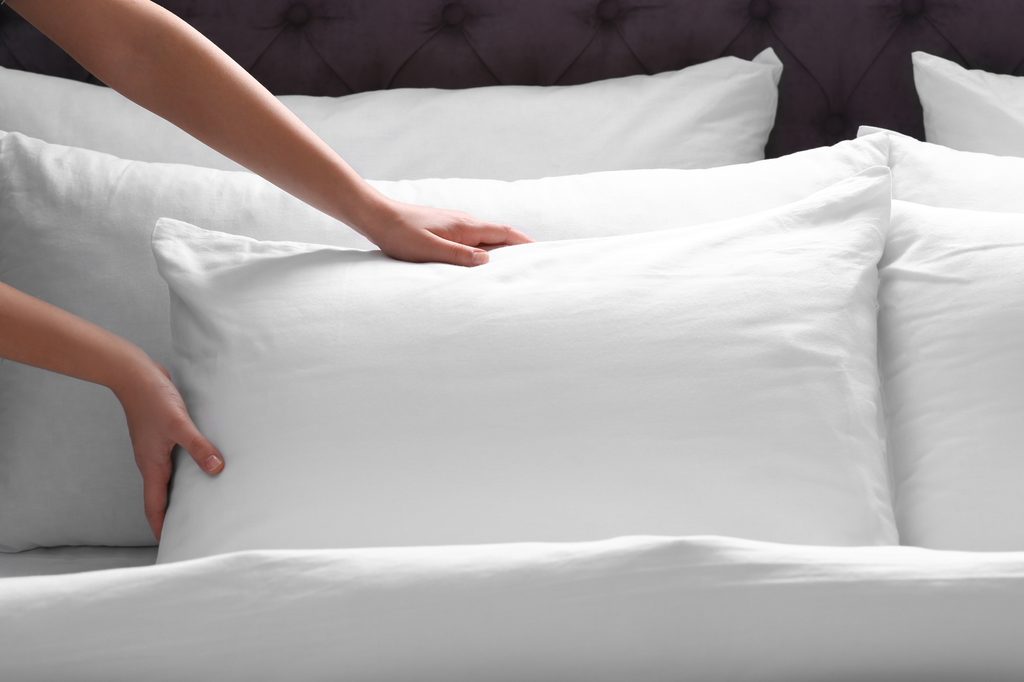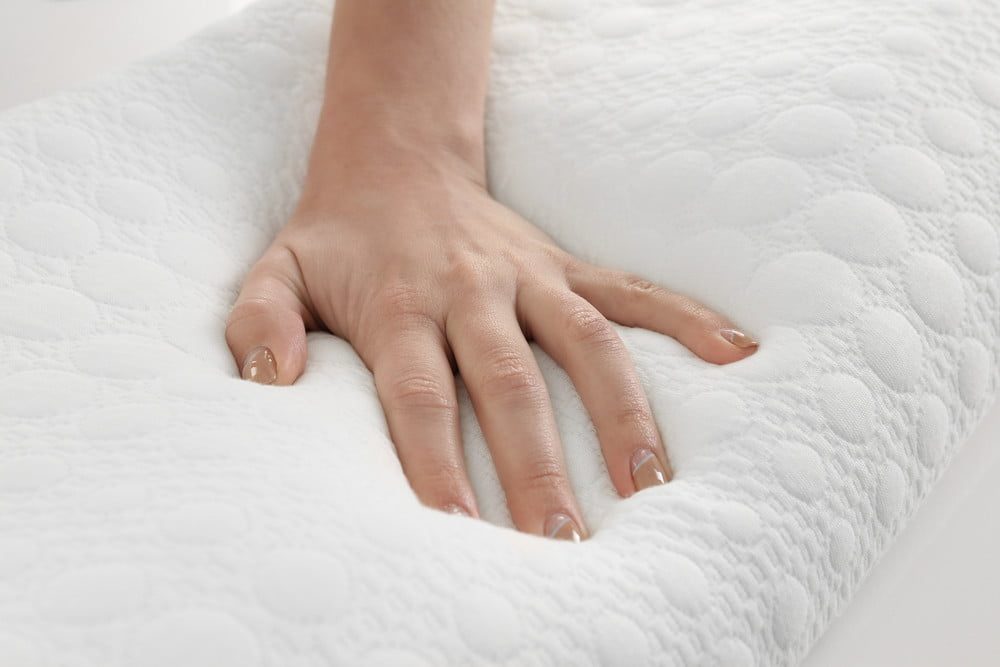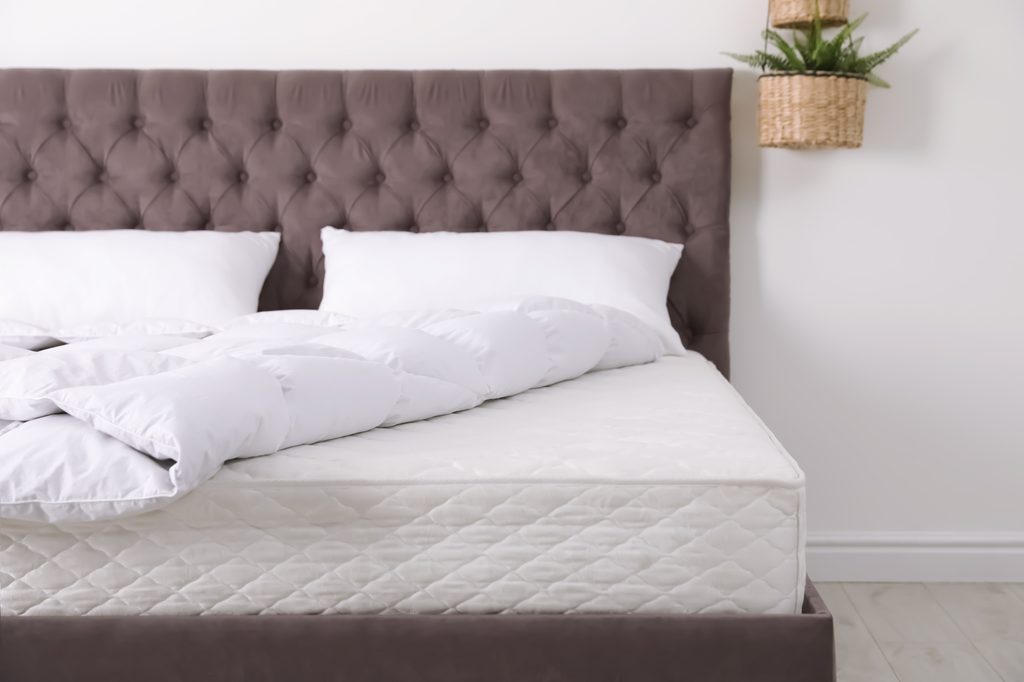
If you’re waking up with aches and pains or a foggy head even after upgrading your mattress, there’s one area you might have missed — your pillow. Having the right pillow is just as important as your mattress, and a few of the same tips for selecting a mattress apply to your pillow. The good news is that we’ve got everything you need to discover how to choose a pillow that’s perfect for you.
Let’s dig into everything from materials and thickness to choosing a pillow that’s specific to an issue you may have. Here’s what you need to know!
Why does your pillow matter?

A good pillow can work with your mattress to keep your spine aligned and your posture correct, say WebMD. It also provides enough air circulation that you’re less likely to toss and turn, increasing your chances of wrenching a muscle during the night.
How often should I replace pillows?

Pillows don’t last nearly as long as mattresses, so if you’ve had your pillow for more than three years, it’s time to let it go, says NBCNews. And if you’ve had a low-quality pillow for more than 18 months or so, you’re way past due for a new one.
Over time, pillows accumulate dust mites, sweat, and allergens, which can affect your health and sleep quality. If your pillow is lumpy, flat, or no longer holds its shape, it’s time for a new one. Regularly washing pillows and their covers and using pillow protectors can extend their lifespan, but timely replacement is key for optimal comfort and cleanliness.
How to choose a pillow filling

Memory foam pillows might be all the rage, but they aren’t the only option out there — far from it. To pick a pillow filling that is right for you, consider the position you sleep in, how hot you get while sleeping, and, of course, your budget.
Here are some of the best pillow-filling materials to consider.
Memory foam
Let’s get right to this one, since it’s having a bit of a heyday. Memory foam is designed to conform to your head and neck, providing easy positioning. This filling is naturally hypoallergenic, resisting mold and mildew growth as well as other types of pests, but it has some drawbacks.
- It has a distinct smell at first, which fades with time.
- It can cause something called ‘off-gassing,’ Molekule Science explains, which is when the pillow releases chemicals that might cause allergic reactions. If you’re worried about this, look for pillows that are CertiPur-US certified.
- Memory foam is known for holding in body heat, so choose one that has good air circulation. Options like gel-infused memory foams can also help pull heat and moisture away from your head.
- They’re also heavier and aren’t designed to tuck into your shoulder.
Latex
Natural latex doesn’t have the same problems with off-gassing that memory foam does, but they are going to be a bit more expensive. They’re typically cooler, however, and offer the same antimicrobial properties as memory foam.
Natural latex is made through a complex process, adding to the cost, but it does provide users with an ultra-conforming material, explains MadeHow. Latex is still a heavyweight pillow and isn’t designed to be tucked into your shoulder. Instead, it lays flat and molds to your shape as you move around.
Polyester
Polyester fills are on the more affordable side and provide a lightweight, ultra-fluffy pillow for general use. They’re what you see in most big box stores and can provide general-purpose support for those of you on a tighter budget.
They don’t last nearly as long as memory foam or latex fills, however, so you might find yourself replacing your pillow a lot more often. Polyfill is pretty cooling and often provides good air circulation. Plus, it’s perfect for those of you who like to tuck a pillow underneath your neck and head.
Down
Down pillows used to be the end-all of pillow comfort, but they’re mostly known for allergies and feathers sticking out of the material. Down pillows do provide good air circulation and are the most moldable of all pillows as long as you get one with multiple layers to secure those feathers.
Down alternatives behave a lot like down but don’t produce the same types of allergies that real down does. Both types are on the expensive side but could be a good idea for those who don’t need a full fill.
Other materials
Cotton is another type of material that behaves a lot like polyester fill, but these pillows do tend to be a little flatter than most pillows. However, they’re suitable for chemical sensitivities if you can find organic cotton fill.
Wool is another less-familiar material, but if you suffer for temperature variations during the night, it’s a good option. It quickly wicks away heat and sweat from your head, much like your favorite hiking socks. These pillows are quite firm.
Consider your sleep position

Your sleep position also affects your pillow type.
- Stomach sleepers – Look for a low-fill pillow that conforms to your neck and head without elevation, said Good Housekeeping. A down (or down alternative) pillow is good for this, as is a thin memory foam pillow. Wool may be too firm.
- Side sleepers – Look for a thick-fill pillow such as memory foam or latex. These materials prevent your head from collapsing into your shoulder and provide space in the neck area to keep your spine aligned. They also hold their shape throughout the night.
- Back sleepers – Medium fill and firm pillows work well here. If you have back issues or you snore, you need a pillow that prevents airway blockage. Polyfill or memory foam/latex is usually appropriate, as is the firmness of wool.
- Combination sleepers– Medium fill is also good here, and a moldable pillow works well for position changes. Memory foam can also conform comfortably to your body no matter what position.
Complement your mattress type

Often, a rule of thumb is to go opposite your pillow to your mattress type. If you use a firm mattress, you may need a softer pillow to allow for more conformity with your body position and type. If you have a softer mattress, a firm pillow can prevent your head from sinking into the mattress too far. You always want to keep your spine aligned.
Knowing how to choose a pillow that aligns with your sleep needs can significantly improve your overall sleep quality. The right pillow works hand-in-hand with your mattress to support your spine and ensure a comfortable, restful night. By considering factors such as pillow materials, your sleeping position, and the type of mattress you use, you can find the ideal pillow that will keep you comfortable and supported throughout the night. So, take the time to evaluate your options and make an informed decision on how to choose a pillow that’s perfect for you, ensuring you get the restful sleep you deserve.


